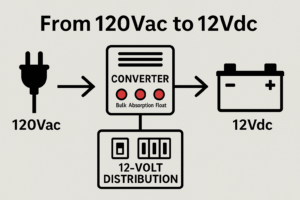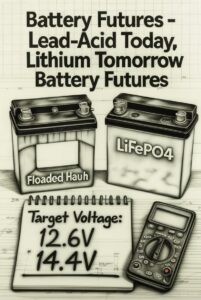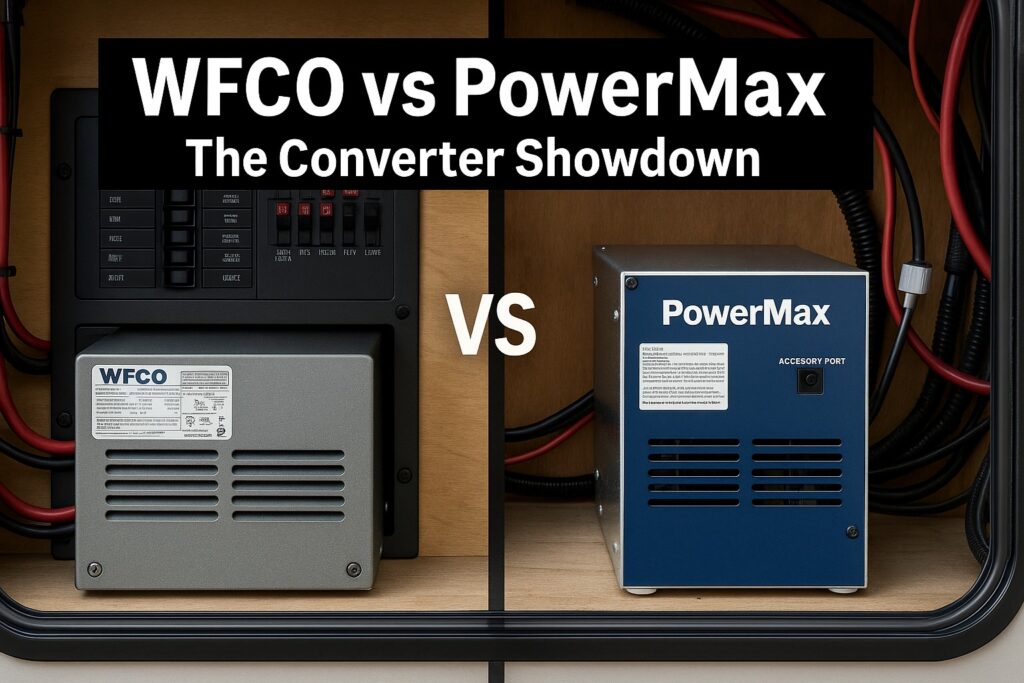WFCO vs PowerMax RV Converters: Which One’s Right for Your Rig?
Introduction
 If your lights are flickering, your batteries aren’t holding a charge, or your fan spins up like a jet whenever you plug in, your RV converter may be the culprit—or your next best upgrade. Two names dominate DIY discussions: WFCO vs PowerMax. Both brands offer multi-stage charging and dependable 12-volt DC power for your coach, but they approach things a little differently. In this guide, we’ll break down WFCO vs PowerMax converters, highlight the PowerMax MBA as a replacement for WFCO MBA units, and help you decide what’s best for your batteries, camping style, and budget.
If your lights are flickering, your batteries aren’t holding a charge, or your fan spins up like a jet whenever you plug in, your RV converter may be the culprit—or your next best upgrade. Two names dominate DIY discussions: WFCO vs PowerMax. Both brands offer multi-stage charging and dependable 12-volt DC power for your coach, but they approach things a little differently. In this guide, we’ll break down WFCO vs PowerMax converters, highlight the PowerMax MBA as a replacement for WFCO MBA units, and help you decide what’s best for your batteries, camping style, and budget.
Bottom line up front: If you want a “set-it-and-forget-it” converter for traditional flooded lead-acid batteries, WFCO has long been a solid choice. If you want adjustable voltage and easier lithium compatibility in a drop-in replacement, PowerMax earns serious consideration—especially the MBA series designed to swap into WFCO 8900 power centers.
How RV Converters Work (and Why It Matters)
Your converter takes campground (or generator) 120 Vac and converts it to 12 Vdc to run lights, fans, water pumps, circuit boards, and to charge your house batteries. The quality of that charging profile matters for battery health and lifespan:
Bulk: Fast charging at a higher current to raise the state of charge quickly.
Absorption: Controlled voltage to complete the charge without overcooking plates.
Float: Lower, maintenance voltage to keep batteries topped without damage.
Different chemistries (flooded lead-acid, AGM, lithium LiFePO₄) like different voltages and timings. That’s where the WFCO vs PowerMax conversation usually starts: fixed profiles vs. adjustable output.
WFCO Converters: Overview
WFCO converters have been common in OEM RV power centers for decades. Their hallmark is a 3-stage smart charging profile that reliably works with everyday lead-acid batteries and typical RV loads.
What RVers like:
“Install it and forget it” behavior for standard setups.
Available across a wide range of amp ratings (common models 35A–75A).
Integrated power centers that are common in travel trailers and fifth wheels.
Common complaints you’ll hear:
On some rigs and use cases, the converter may linger around ~13.6V absorption, which can feel slow for aggressive charging expectations.
Lithium users sometimes want higher/adjustable voltages or a dedicated lithium profile.
Best for: RVers sticking with flooded lead-acid or AGM, who value a proven, OEM-style solution without tinkering.
PowerMax Converters: Overview
PowerMax offers a competitive lineup with 3-stage charging and, in many models, adjustable voltage. That adjustability is the headline for battery nerds and lithium adopters. Of particular interest to DIYers is the PowerMax MBA series, marketed as a drop-in replacement for WFCO 8900-series MBAs.
What RVers like:
Adjustable voltage (often cited ~13.0V–16.5V depending on model) for dialing in flooded, AGM, or lithium profiles.
MBA series fits WFCO 8900 trays, making swaps straightforward.
Typically priced lower than comparable alternatives.
Potential tradeoffs to note:
Perceived build “heft” varies by model; price-point products can feel lighter than some OEM units.
As with any brand, real-world longevity depends on installation quality, ventilation, and load profile.
Best for: RVers wanting voltage flexibility, lithium readiness, and a budget-friendly upgrade path—especially if you plan to keep the existing WFCO power center but want different charging behavior.
WFCO vs PowerMax: Side-by-Side Comparison
1) Charging Performance
WFCO: Stable 3-stage charge behavior that suits flooded lead-acid well; some users find it conservative when they want faster absorption or equalization behavior.
PowerMax: 3-stage charging with adjustable voltage on many models adds control for AGM and lithium chemistries. If you’ve moved to LiFePO₄, that flexibility is a big win.
Verdict: If you want tunable charging, PowerMax has the edge. For classic lead-acid and simple operation, WFCO remains an easy pick.
2) Lithium Readiness
WFCO: Many units will run lithium, but you may wish for a profile closer to your battery manufacturer’s specs.
PowerMax: The ability to customize voltage is why many lithium users lean this way.
Verdict: PowerMax for lithium ease.
3) Noise & Efficiency
Both brands use thermostatically controlled fans. In healthy, properly ventilated installs, fan noise is usually modest.
Efficiency varies by model, but both aim to keep electrical noise (RFI/EMI) low to avoid messing with radios and TVs.
Verdict: Functionally similar for most RVers when installed with adequate ventilation and correct gauge wiring.
4) Cost & Value
PowerMax models often sell for less than comparable alternatives, which is appealing for budget-minded upgrades.
WFCO’s widespread OEM presence can translate to easy availability and broad community familiarity.
Verdict: PowerMax typically wins on purchase price; WFCO wins on “everyone knows it” familiarity.
5) Support & Reliability
Both brands are established in the RV aftermarket. Reliability is heavily influenced by installation quality, load patterns, and battery health.
Warranty terms vary by model and seller; check current listings before you buy.
Verdict: Call it a draw—pick a reputable vendor and confirm current warranty details.
6) Installation Fit & Compatibility
WFCO units fit WFCO power centers by design.
PowerMax MBA units are marketed as drop-in replacements for WFCO 8900 series MBAs (commonly referenced WF-8935/8945/8955/8975). That means you can keep your distribution panel and just swap the converter “guts.”
Verdict: If you already have a WFCO 8900 power center and want different charging behavior, the PowerMax MBA swap is the simplest path.
Can a PowerMax MBA Replace a WFCO MBA?
Yes—that’s the point of the PowerMax MBA line. It’s engineered to slide into WFCO 8900-series trays as a drop-in MBA replacement while providing the same fundamental job: convert 120Vac to 12Vdc and smart-charge your batteries.
What to expect in the swap:
Power down: Unplug shore power, turn off the generator, and disconnect battery negative (safety first).
Access the tray: Remove the existing WFCO MBA module from your 8900-series power center.
Wire mapping: Transfer AC input and DC output wires one-for-one. Pay attention to polarity; color schemes can differ (e.g., WFCO positive often red; PowerMax may mark positive differently—always confirm labels).
Secure & ventilate: Mount the PowerMax MBA with the original screws, confirm fan clearance, and ensure ventilation isn’t obstructed.
Reconnect & test: Reconnect battery negative, restore AC power, verify output voltage, and check that 12-volt loads behave normally.
Pro tips:
Photograph your wiring before you start; it’s the best insurance against mistakes.
Match the amp rating to your rig. Upgrading from 35A to 75A or 100A? Confirm wire gauge and fusing are adequate for the higher current.
After installation, measure converter output at the battery with a multimeter. Verify that bulk/absorption/float (or your chosen setpoint) aligns with your battery manufacturer’s specs.
Which Converter Should You Choose?
Use this quick decision guide:
You run flooded lead-acid, camp with hookups, and want OEM-style simplicity.
Go WFCO. It’s set-and-forget, widely used, and straightforward.You run (or plan to run) lithium, or you want control over charge voltage.
Go PowerMax—especially an MBA if you have a WFCO 8900 power center. Adjustable voltage can help you hit the exact targets your LiFePO₄ battery maker recommends.You’re troubleshooting slow charging or dim lights on an older WFCO.
A PowerMax MBA swap can be a cost-effective refresh, potentially improving charge behavior without replacing your whole panel.
Practical Tips for a Smooth Upgrade
Audit your battery: Note chemistry (flooded/AGM/lithium), capacity (Ah), and age. The “right” converter profile starts with the battery.
Size correctly: Don’t oversize the converter “just because.” Higher amps demand heavier wire, better ventilation, and appropriate fusing.
Ventilation matters: Converters are happiest when they can shed heat. Poor airflow shortens life and ramps up fan noise.
Protect your investment: Use clean, tight terminations; replace corroded lugs; route wires neatly; and label your work for the next owner (or future you).
Keep a multimeter handy: Verify voltage at the battery posts, not just the converter terminals. Voltage drop is real.
Troubleshooting After the Swap
Lights still flicker? Check battery health, DC negative bonding, and chassis grounds. Weak batteries or poor grounds can mimic converter problems.
Fan running constantly? High loads or poor ventilation will make the fan roar. Reduce load, improve airflow, and recheck.
Lithium not hitting target voltage? Confirm your model supports adjustable voltage (or a lithium mode) and set it according to your battery maker’s spec sheet.
Conclusion for The Smart RVer
 Both WFCO and PowerMax deliver reliable 12-volt power and multi-stage charging, but they shine for different RVers. If you value OEM simplicity for standard lead-acid banks, WFCO is a safe, familiar pick. If you want voltage adjustability, lithium friendliness, and a budget-minded upgrade—especially without replacing your whole WFCO power center—the PowerMax MBA is a compelling solution.
Both WFCO and PowerMax deliver reliable 12-volt power and multi-stage charging, but they shine for different RVers. If you value OEM simplicity for standard lead-acid banks, WFCO is a safe, familiar pick. If you want voltage adjustability, lithium friendliness, and a budget-minded upgrade—especially without replacing your whole WFCO power center—the PowerMax MBA is a compelling solution.
For The Smart RVer community, the winning choice comes down to battery chemistry, how you camp, and how much control you want over charging. Make the call that supports your batteries today—and the upgrades you’re planning tomorrow.
Is PowerMax better than WFCO for lithium?
Often, yes—PowerMax adjustable voltage lets you hit lithium-friendly setpoints more easily.
Can a PowerMax MBA replace a WFCO MBA in the 8900 series?
Yes, that’s what the MBA is designed for—a drop-in replacement with minimal wiring changes.
Do I need to change my wiring when increasing converter amps?
Possibly. Higher amperage demands heavier gauge wire and correct fusing. Check ampacity charts and follow best practices.
Will either brand fix bad batteries?
No converter can resurrect a sulfated or failing battery bank. Test and replace batteries as needed.
